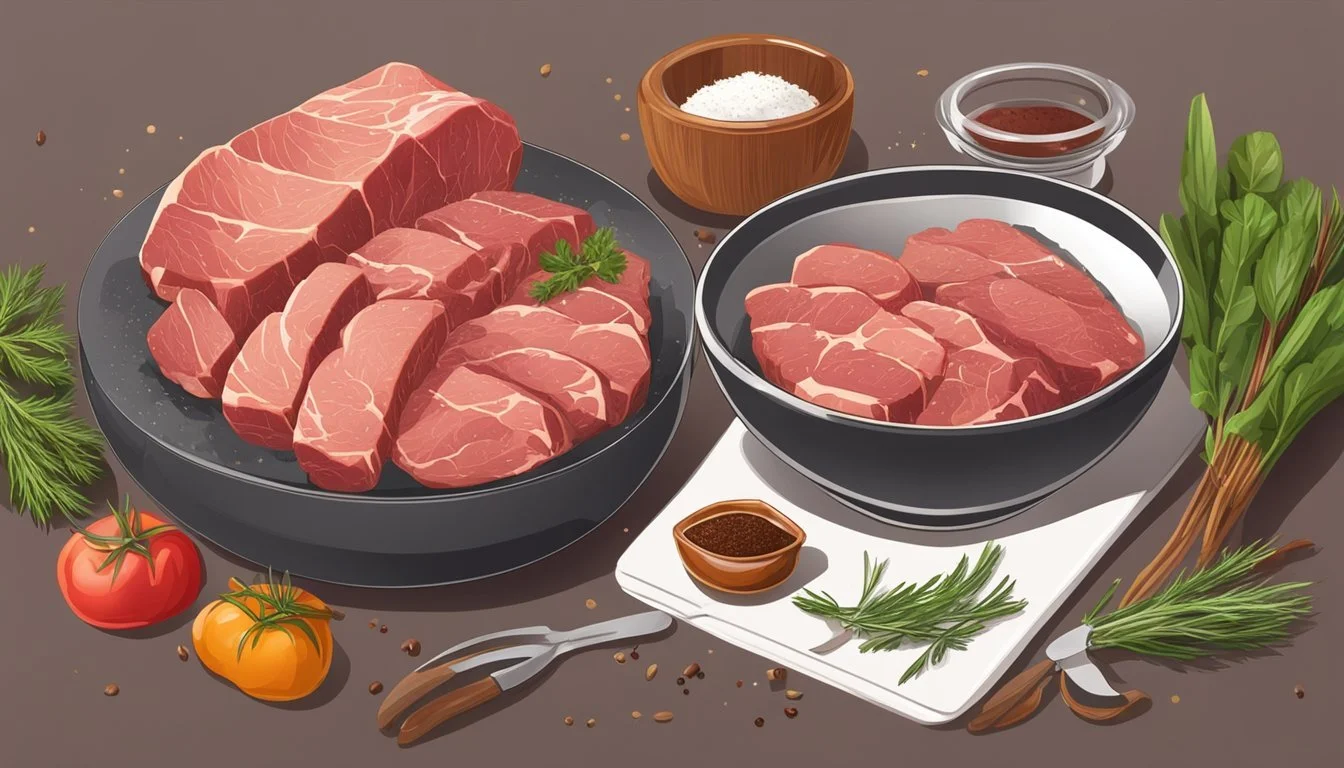What Wine Goes Well with Bison?
Perfect Pairings for Your Game Dinner
Bison (What wine goes well with bison?) meat is known for being a lean alternative to beef, offering a rich, slightly sweet flavor paired with a tender texture. Its unique taste profile makes bison a prime candidate for creating sophisticated culinary experiences. To enhance these attributes, selecting the right wine is crucial. A well-chosen wine not only complements the meat but can also elevate the entire dish to a new level of gastronomic pleasure.
Wine pairing with bison is similar to pairing with beef, in that red wines are often the preferred choice due to their ability to complement red meat's (What wine goes well with red meat?) robust flavors. However, due to bison's lower fat content, it's important to consider wines that balance this lean protein without overwhelming it. Medium to full-bodied red wines with a harmonious blend of tannins and acidity are often recommended. These wines include those made from Pinot Noir, which are known for their low tannin and acidity with silky textures and notes of berry and cherry. Other suitable options might exhibit black fruit flavors and possess silky tannins, lending a rich body that can match well with the meaty savoriness of bison.
When preparing bison, whether it’s in the form of a roast, burger, or steak, cooking it at a lower temperature to a medium rare is generally advised, preserving the meat’s natural juiciness and tenderness. Serving it alongside a glass of well-matched wine creates a harmonious combination on the palate, delivering a memorable dining experience.
The Basics of Bison
When considering bison as a culinary option, it's important to recognize its qualities as a protein source and understand the health benefits it offers due to its composition.
Understanding Bison as a Protein Source
Bison stands out as a rich protein source, comparable to other meats such as beef. The key difference lies in its lower fat content. Typically, a serving of bison offers substantial protein, aiding in muscle repair and growth, while being remarkably lean. It's often grass-fed, contributing to a favorable fatty acid profile, including higher levels of omega-3.
Health Benefits of Bison Meat
Choosing bison meat comes with several health advantages. Being low in fat compared to traditional red meats, bison offers a heart-healthy alternative for meat enthusiasts. It's also generally less calorie-dense due to its leanness, supporting weight management efforts. Additionally, for those seeking ethical and environmentally friendly meat options, bison is often raised in less intensive farming systems.
Wine Pairing Principles
When selecting a wine to accompany bison, one must carefully consider tannin structure, flavor harmony, and the balance between acidity and body. These elements are crucial to enhancing the dining experience.
The Impact of Tannins on Pairing
Tannins in wine play a significant role in pairing, as they can interact with the protein and fat content of bison. Wines with a lower tannin content, such as a Pinot Noir, complement bison's leaner profile by providing a smooth, supple pairing that doesn't overpower the meat. A more tannic wine might be suitable for fattier cuts but could overwhelm less fatty preparations of bison.
Balancing Flavors and Aromas
To create a seamless pairing, the flavors and aromas of the wine should complement those of the bison dish. The combination should highlight berry and cherry flavors with hints of floral notes, which can be found in varietals like Chilean Pinot Noir or a Toscana Blend. These wines offer a rich body and distinctive fruit flavor that can stand up to savory spices and marinades often used with bison.
Considering Wine Acidity and Body
The wine's acidity and body must match the preparation of the bison. A wine too acidic or too full-bodied can disrupt the balance with the meat's natural flavor. A moderate acidic red wine, such as a Malbec, has the capacity to cut through the richness of bison without overshadowing it. A German Riesling or Burgundy Chardonnay could also offer a white wine alternative that complements the dish with their respective acidic levels and body.
Selecting the Right Wine
When pairing wine with bison, the wine's body, tannin structure, and flavor profile are critical factors to consider. Bison meat's lean and rich qualities require careful selection to enhance the dining experience.
Best Red Wines for Bison
Bison's robust flavors harmonize well with full-bodied red wines. Here's a breakdown of top pairings:
Tempranillo: Exhibits a balance of fruit and savory notes, making it a versatile match.
Malbec: Known for its dark fruit flavors and smooth finish, it pairs nicely with grilled bison.
Syrah: Offers peppery notes that complement bison's gamey taste.
Cabernet Sauvignon: With its bold tannins, it stands up to bison's richness.
Zinfandel: A fruit-forward option that can highlight the meat's natural flavors without overpowering.
Pinot Noir: Serves as a lighter red that can still align with bison due to its earthy undertones.
Sangiovese: Brings acidity and herbal notes to the table, which can cut through the meat's density.
Nebbiolo: Provides a tannic structure and complexity suited to bison's flavor.
Merlot: A softer option with enough body to support the pairing.
When to Choose a White Wine
While red wine is the traditional choice for red meats like bison, white wine can also be considered in certain circumstances:
Chardonnay: A full-bodied white with oaky notes may work well with bison served in a creamy sauce.
Rosé: A more robust rosé can sometimes bridge the gap between red and white, offering versatility with lighter bison preparations.
Understanding Wine Labels and Regions
The wine’s origin can be as telling as its varietal. Reading labels for region and vintage ensures a suitable pairing:
Old World Wines (e.g., Italy, France): Tend to have higher acidity and earthier flavors than their New World counterparts.
New World Wines (e.g., USA, Argentina): Often exhibit bolder, fruitier profiles, which can complement the natural sweetness in bison meat.
Vintage year can indicate the wine’s character, with older wines generally being less tannic and more mellow.
Selecting the right wine involves not only matching the wine's characteristics with the meat’s flavor but also considering the preparation method and accompanying sauces or rubs. The above suggestions are starting points, and personal preference should guide the final choice.
Preparing Bison
Preparing bison requires careful attention to cooking techniques and seasoning to enhance its lean and rich flavor profile. Understanding the ideal doneness is also crucial to ensure a tender and juicy meal.
Cooking Techniques for Bison Meat
Bison meat tends to be leaner than beef and should be cooked at a lower temperature to avoid overcooking. When preparing a bison steak, searing on high heat initially and then letting it finish cooking at a lower temperature is beneficial. For bison burgers, cooking them on a preheated grill or pan yields the best results. Due to the meat's leanness, keeping the cooking time short is key to a moist and flavorful dish.
Seasoning and Marinating
When it comes to seasoning bison meat, simplicity often works best. A dry rub comprising salt, pepper, and garlic can complement the meat's natural flavors. For those seeking more complexity, a blend of thyme, or a chimichurri sauce, can add a fresh and aromatic note. Marinating with Worcestershire sauce or a similar concoction should be done cautiously to not overpower the meat's inherent taste.
Determining Doneness
The ideal doneness for bison is medium rare. Using a meat thermometer is the most reliable method to achieve the perfect internal temperature of 130°F (55°C) before resting the meat. After removing the bison from the heat source, wrap it in foil and let it rest for 10-15 minutes. This step allows the juices to redistribute, ensuring that every bite is as succulent as the last.
Pairing Wine with Different Bison Dishes
Selecting the right wine to complement bison dishes is essential for rounding out the dining experience. The leaner profile of bison meat pairs elegantly with certain red wines, enhancing both the dish and the beverage.
Bison Steaks and Red Wine
Bison steaks, with their deep flavors, are ideally served with red wines that exhibit a balance of fruit notes and tannic structure. A medium to full-bodied red wine like a Cabernet Sauvignon brings out the richness of a bison tri-tip. The robust flavors of the meat can stand up to the boldness of the wine, especially when the steak is prepared with marinades or spice rubs that include ingredients like roasted garlic and red pepper flakes.
Wine Pairing for Bison Steak:
Type: Full-bodied Red Wine
Varietal: Cabernet Sauvignon
Serving: 65°F (18°C)
Dish: Bison tri-tip with a roasted garlic rub
Bison Burgers and Wine Selection
The inherent flavors of ground bison in a burger form a delightful match with a medium-bodied red wine, which complements without overpowering the dish. A wine like a Merlot or a Zinfandel, with their juicy fruit notes, can enhance a range of burger preparations, whether it's simply seasoned or loaded with bold toppings like blue cheese and butter-grilled onions.
Wine Pairing for Bison Burger:
Type: Medium-bodied Red Wine
Varietal Options: Merlot, Zinfandel
Serving: Slightly cooler than room temperature
Dish: Bison burger with blue cheese and grilled onions
Adventurous Pairings and Accompaniments
Pairing wine with bison doesn't end with steaks and burgers. Adventurous dishes like bison chili or spicy tacos open the door for wines that can handle an array of spices and flavors. A Syrah, known for its peppery notes, pairs nicely with these heartier dishes. For a lighter dish such as a bison salad with green vegetables and a vinaigrette, a lighter red wine like Pinot Noir will not overshadow the flavors.
Adventurous Bison Dishes:
Chili or Spicy Tacos:
Wine: Syrah with peppery undertones
Serving: 60-65°F (15-18°C)
Green Salad with Bison:
Wine: Pinot Noir
Serving: Served chilled, around 55°F (13°C)
Serving and Enjoying the Pairing
When pairing bison with wine, one should pay attention to details such as presenting the dish attractively, storing and serving the wine at the correct temperature, and selecting the appropriate glassware to enhance the tasting experience.
Presentation and Serving Tips
Presenting bison with the right wine not only complements its flavors but also turns a simple meal into an elegant dining experience. Serve bison in thoughtful portions, ideally as the main course on a pre-warmed platter, to retain its warmth. Arrange the meat neatly with garnishes that complement the dish and the wine. For example, a sprig of rosemary can add both visual appeal and aromatic harmony to a bison roast paired with a full-bodied red wine.
Storing and Serving Wine at the Right Temperature
Storing wine at the right temperature is essential for its flavor profile to fully develop. Red wines, commonly paired with bison, should be stored at approximately 55°F (13°C) and served slightly cooler at around 60-65°F (15-18°C):
Full-bodied red wines: Serve at 60-65°F (15-18°C)
Medium-bodied red wines: Serve at 55-60°F (13-15°C)
An inaccurate serving temperature can negatively impact the wine’s taste and the overall pairing experience.
The Role of Glassware
Choosing the right glassware is pivotal in a wine pairing experience. The shape of the wine glass can influence the wine's interaction with air and its delivery to the palate. For bold red wines often chosen for bison, one should opt for glasses with a larger bowl that allows the wine to breathe and release its nuanced flavors.
Bordeaux glass: Ideal for full-bodied red wines with higher tannin levels
Burgundy glass: Suited for medium-bodied red wines that are more delicate
Glassware should be spotless and clear, ensuring that the wine's color and consistency can be fully appreciated.
Additional Tips and Considerations
When pairing wine with bison, while the primary concern is flavor harmony, there are other crucial aspects to consider such as health implications, the effect of sides and spices on the pairing, and suitable wine choices for special occasions.
Health Considerations and Moderation
Bison meat is leaner than beef, often lower in calories and fat, but rich in protein, making it a healthier alternative. Moreover, it contains conjugated linoleic acid (CLA), which has been linked to health benefits. In terms of wine, moderation is key due to calories and sugar content. One should balance enjoyment of the meal with mindful consumption to ensure a health-conscious approach to dining.
Pairing Wine with Sides and Spices
The side dishes and spices accompanying bison can influence the wine choice. For example:
Sides like roasted vegetables: May pair well with medium-bodied red wines that carry a balance of fruit and tannins.
Spices or marinades: Spicy rubs or rich marinades on bison demand a wine that can complement these strong flavors without overpowering them. Here, a red wine with subtle tannins and a hint of berry fruitiness might be appropriate.
Selecting a wine with a silky texture could enhance a dish's overall mouthfeel, harmonizing the flavors of both the food and the wine.
Recommended Wines for Special Occasions
For special occasions, it is customary to choose a wine that is as memorable as the event:
Celebratory Dinners: A vintage Bordeaux blend offers the richness and complex flavor profile suited to match the boldness of bison.
Intimate Gatherings: For smaller, more intimate settings, a Toscana blend with its distinctive black fruit flavor could complement bison dishes well, ensuring that the meal is memorable.
Pairing bison with wine creates an opportunity to explore a range of red wines known for their body, flavor, and structure that not only stand up to the robust nature of bison meat but can also elevate the dining experience.







